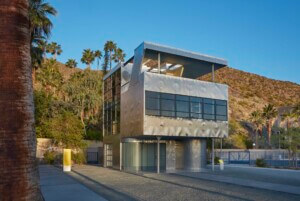A 56-foot-long aluminum sculpture leaps into Sacramento’s new airport.
Whether they need a reminder that they’re late (for a very important gate!) or welcome a distraction from the hassle of modern travel, visitors to Sacramento’s International Airport will not miss Denver-based artist Lawrence Argent’s Leap sculpture. Completed last month in the new Corgan Associates-designed Terminal B, the 56-foot-long red rabbit is suspended mid-jump in the building’s three-story central atrium. An oversize “vortical suitcase” placed in the baggage claim below completes the piece. Argent worked with California-based Kreysler & Associates, a specialist in the design, engineering, and fabrication of large-scale sculptural and architectural objects, to build his vision while meeting the airport’s safety requirements.
- Fabricator Kreysler & Associates
- Designer Lawrence Argent
- Location Sacramento, California
- Status Complete
- Materials Aluminum, crushed glass surface, custom stainless steel cable and hardware
- Process 3-D modeling, CNC fabrication
The team originally planned to build the sculpture with glass fiber composite, but fire codes would have required additional engineering studies to prove it was flame retardant. Additionally, the building was going to be largely enclosed by the time the sculpture was ready for installation, making it impossible to bring the sculpture, which is 14 feet wide and more than 16 feet high, into the building in one piece.
Argent had designed the sculpture as a form composed of hundreds of flat triangles. “The piece lent itself to aluminum as long as we could figure out how to fabricate the pieces,” said Bill Kreysler, who founded the fabrication company in 1982. Working with Argent’s digital renderings, Kreysler’s team translated the design into Rhino, creating what he calls a semi-monocoque structure with a double-skin of thin aluminum on a thin-ribbed interior aluminum frame. The decorative surface is composed of 1,446 CNC-cut triangles with side dimensions ranging from 1 inch to 3 feet. Etched with a numbering system, the triangles were placed using laser-projected grid lines.
“I think that one of the things that is often overlooked in this digital fabrication world is that there’s a sense that because computers are controlling the process, the human element is reduced, but in many ways it’s increased,” said Kreysler, who limited the number of people working on the piece to ensure consistency.
The rabbit’s interior structure was assembled into 14 pieces of varying diameters in the shop, then transported to the airport for assembly. The exterior aluminum triangles are textured with crushed glass to create a velvet-matte surface and float 1½ inches above the interior shell with aluminum standoffs.
Even in the light-filled atrium space the sculpture’s suspension system appears minimal. The concentrated loads coming from seven custom wire rope suspension cables with swage fittings are received by the rabbit’s internal steel armature. Aluminum transverse members then distribute these loads from the steel armature to the monocoque aluminum shell.
Unveiled on October 6, the new $1.3 billion airport addition is the largest construction project in Sacramento’s history. The rabbit is the centerpiece of the 14 art installations—more than $6 million worth—commissioned by the city’s Metropolitan Arts Commission and planned for completion in the coming years.










